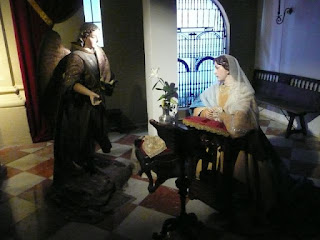We had purchased a day trip across the Straight of Gibraltar to Tangere, Morocco for Saturday. It was to have been a long day, departing the hotel at 5:45 a.m. and returning about 8 p.m., but we were both quite excited about it. Alas, a phone call to our hotel room on Friday night announced that the trip had been canceled because the required minimum number of clients had not been reached. Apparently few wanted to visit a Muslim country on Christmas Eve.
 |
| We used Saturday to visit the nearby city of Málaga. |
We used the day, instead, to take the regular city bus on our own to downtown Málaga. A metropolitan area of more than 700,000, Málaga is a bustling port of call for heavy cargo vessels, as well as for Mediterranean cruise ships. But like Sevilla, Cordoba, or Sevilla, it has at its core an Medieval Muslim village, a royal palace/fortress, and an ornate 16th century cathedral. Add a few Roman ruins and 20th century art for good measure, and it’s a place very much worth visiting.
 |
| The Virgin Mary as a 16th century Spaniard. |
The cathedral featured a near life-sized Belen (nativity scene) which one would only see at this time of year. One could be forgiven for confusing the figure of the Virgin Maria for one of Queen Isabella -- they frequently share similar 16th century fashion tastes. This cathedral did not have the huge altar piece of gilded statuary common to many Spanish cathedrals, but did have a lot of something of which the others have very little: stained glass. A pair of baroque pipe organs is another feature shared by many of these churches. We aren’t sure if their for dueling among organists or because they were complicated machines for their time and often broke down.
 |
| One of the two large Baroque pipe organs in Málaga cathedral. |
Pablo Picasso was born and raised in Málaga. He didn’t think much of the place, as he left at age 19 and never returned. Málaga, however, thinks a great deal of him and has built a wonderful Picasso museum. I’ve seen a number of his works in other places, but seeing so many from so many periods of his life in one place was quite instructive.
 |
| The Roman amphitheater in Málaga. |
The ruins of a Roman amphitheater have been uncovered beneath one of the city’s main plazas, and it has been partially reconstructed for use for events and concerts. We skipped the full tour as we've seen much larger and more complete Roman sites elsewhere, including Britain.
 |
| Alcazaba Palace exterior |
Unfortunately, the Alcazaba Palace was closed for the Christmas holiday. From the outside it appears to be a well-preserved example of mudejar architecture. We did, however, get to visit the Gibralfaro castle, high on the hill above both palace and city. It was quite a climb, and the castle has been heavily reconstructed, but the views of the harbor and down the coast are as breathtaking as the walk up the hill.
 |
| Málaga harbor seen from Gibralfaro Castle. |
After returning to the hotel we spent some time relaxing, then after a slightly earlier dinner, walked up the beach a mile or so to a little Catholic church for Christmas Eve mass. We didn’t understand much, but the shape of the service is the same everywhere, and the Gospel was read in English, as well as in Spanish, for the sake of the many tourists crowded in. From what we could tell of the tourists, it would have been better had they read it in German, instead. The priest also added a brief capsule summary of his sermon in English, after a much longer Spanish version.
 |
| Sunrise Christmas morning from our hotel balcony. |
We walked back along the Promenade in 60+ degrees with the sound of the pounding surf to put us in the Christmas spirit. The sand was the closest thing to a white Christmas here.








No comments:
Post a Comment